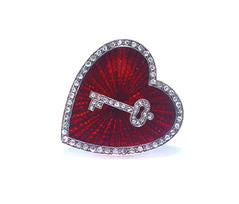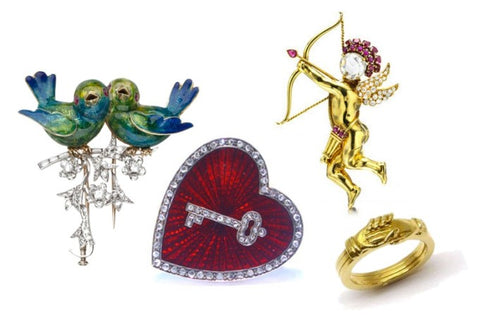
Jeweled hearts, cupid and his arrows, clasped hands, lover’s knots, lovebirds, all are enduring tokens of affection – and favorites to gift a loved one on Valentine’s Day – since ancient times.
I explored earlier this month Victorian sentimental jewelry, but I’d like to look at the other sentimental symbols and their interpretation in jewelry.
Without question, the heart is the most universal representation of love. The first known depiction of a heart as a symbol of romantic love dates to the 1250s, occurring in a miniature decorating a capital S in a manuscript of the French ‘Roman de la poire’.
Miniature (capital S) from a manuscript of the Roman de la poire. This is the earliest known visual depiction of a lover handing his heart to his mistress. The heart is in the shape of a pine-cone (point upward), in accord with anatomical descriptions of the human heart at the time.
Atelier du Maître de Bari. La dame de Thibaud et Doux Regard. Photo courtesy of Wikipedia
In the miniature, a kneeling lover offers his heart to a damsel, the ‘heart’ in his hands resembling a pine-cone in accord with medieval anatomical descriptions. The heart-shape so familiar to us today was developed at the end of the Middle Ages and has been used on playing cards since the late 15th century.
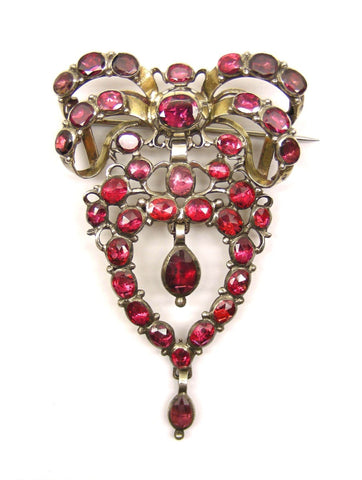
18th century garnet cluster pendant brooch, c.1760
Designed as a ribbon tied bow suspending an openwork heart with central swing drop and smaller swing drop below, close set in silver with oval faceted and rose cut garnets
Available at S.J. Phillips
It goes without saying that jewelers saw the heart as the ultimate expression of love, and what could be a more profound way to give a lover one’s heart made of precious metal and gemstones?
 Some heart jewels include a key motif, with which one symbolically gives the ‘key to my heart’. The key is also seen alongside lockets, conferring the same trust of allowing one to unlock a lover’s heart.
Some heart jewels include a key motif, with which one symbolically gives the ‘key to my heart’. The key is also seen alongside lockets, conferring the same trust of allowing one to unlock a lover’s heart.
Antique ruby and rose diamond key brooch, c.1840 , suspending a moonstone heart with ruby and rose diamond surround, close set in silver and gold.
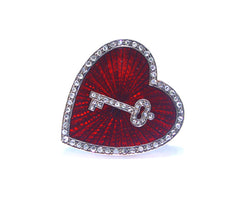 An Edwardian jeweled and enameled brooch
An Edwardian jeweled and enameled brooch
In the form of a heart enameled translucent scarlet over a sunburst guillochage emanating from a diamond set key, bordered with rose diamonds, the reverse with a glass covered compartment.
The brooch is a rebus reading ‘key to my heart forever’, the diamonds being emblematic of eternity.
English, circa 1905.

The son of the love goddess Venus, Cupid is the god of desire, erotic love, attraction and affection. His wings represent lovers’ flightiness, likely to change their minds on a whim, and his boyish appearance reflects how love is foolish and irrational much like a young child. The arrow and torch are Cupid’s symbols “because love wounds and inflames the heart.”
 A ‘Cupid’s bow and quiver’ brooch, in the form of a chased yellow gold bow and quiver containing five removable arrows modeled as gold pins with colored natural pearl finials,the bow set with a white pearl; the pins may also be worn alongside the brooch.
A ‘Cupid’s bow and quiver’ brooch, in the form of a chased yellow gold bow and quiver containing five removable arrows modeled as gold pins with colored natural pearl finials,the bow set with a white pearl; the pins may also be worn alongside the brooch.
Here Cupid’s arrows, surmounted by pearls which are emblematic of his mother Venus, Goddess of Love, are waiting to be fired. English, circa 1895.
Cupid is often depicted with his mother, playing a horn; while in other images, his mother Venus is seen scolding or even spanking him due to his mischievous nature.
An intricately detailed turn of the century Tiffany & Co. Venus and Cupid Cameo. The cameo is made with red and white enameling, set on 18k yellow gold, surrounded by Old European cut diamonds and rubies.
Signed on the back “Venus & Cupid” “Tiffany & Co”

Clasped hands in the form of a ring, known as a fede ring, is yet another recurring motif, symbolizing friendship and love.
‘Fede’ derives from the Italian phrase ‘mani in fede’ (‘hands [joined] in faith’ or ‘hands [joined] in loyalty’), symbolizing faith, trust or ‘plighted troth’. These rings date from Roman times, when the gesture of clasped hands was a symbol of pledging vows, and they were often used as engagement or wedding rings in medieval and Renaissance Europe.
Fede Ring SJ Phillips 19th. century 18ct. gold gimmel/ fede ring, the clasped hands opening to reveal a central hoop, twin hearts motif, engraved cuffs, English c.1860
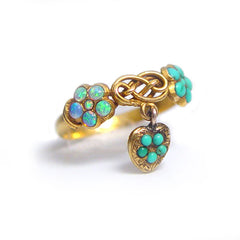 Another favorite wedding or engagement ring also dating from Roman times is a lover’s knot ring, consisting of a complex knot made from wire.
Another favorite wedding or engagement ring also dating from Roman times is a lover’s knot ring, consisting of a complex knot made from wire.
An Antique Victorian Opal and Turquoise Ring, circa 1860 Gold, the central love knot design flanked by two opal-set flowers, the heart-shaped drop also set with opals. The association of knots with the symbolism of love, friendship and affection.
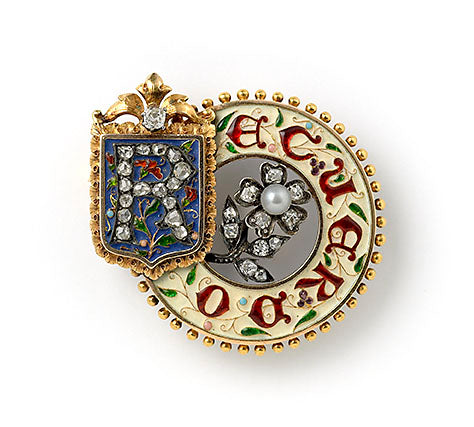
In lieu of symbols, it was popular to attest one’s love through mottoes or mementos, such as jeweled depictions of the words ‘Recuerdo’ (Portugeuse for ‘remember’), ‘Souvenir’ (French for ‘remember’), or simply ‘Love’.
A Gold, Enamel and Gem-set Brooch by Lucien Falize, of circular form featuring the word 'Recuerdo' (memento) in Medieval script, the initial letter carried out in diamonds in a separate cartouche, the rest of the word arranged in a circle in translucent red enamel against an opaque cream ground simulating illuminated script on vellum. The circular form is centred with a diamond-set pansy signifying 'Pensee', translating as a 'thought' or 'memento'.
Maker: Lucien Falize Paris, c.1880.

Victorian gold and turquoise “book” bracelet, unfolding to read “Souvenir.”
English, ca. 1845
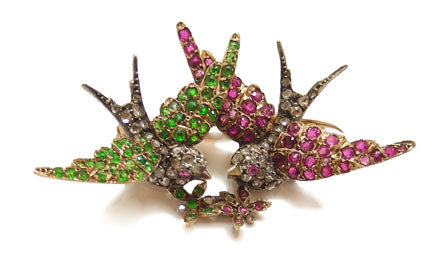
An antique gold and gem-set brooch
In the form of two swallows flying towards each other, the bodies and tail feathers of each set with diamonds, the wings of one set with demantoid garnets, the wings of the other set with rubies, each with gold beaks and ruby-set eyes.
The swallow symbolizes trust and loyalty. The brooch is set with diamonds and rubies, symbolizing lovers united by passionate love. French, circa 1880.
SENTIMENTAL SYMBOLS: LOVE IS ALL AROUND by Jewels du Jour
Article and images from Jewels du Jour, 2014
